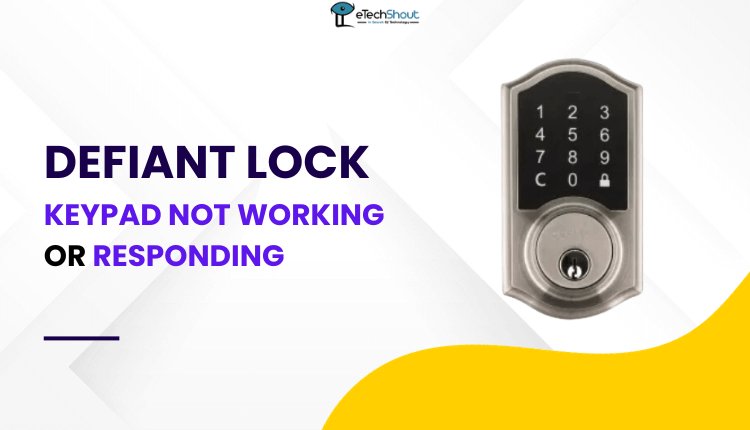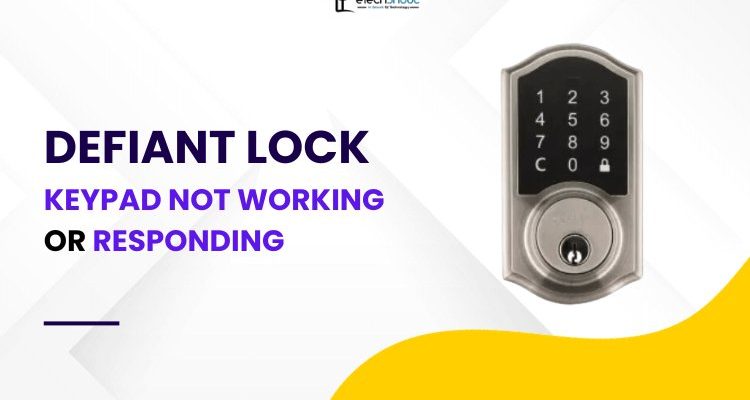
Let me explain: keypad locks—no matter the model or brand—run on a mix of electronics, batteries, and mechanical parts. When something goes off, even just a dying battery or a stuck button, the whole thing can act stubborn. The good news? Most issues don’t mean your lock is truly broken or needs replacing. With a little patience and some step-by-step troubleshooting, you can usually sync things back up.
Check for Obvious Power Issues First
Here’s the thing: most keypad locks depend entirely on batteries. That’s their heartbeat. If the lock isn’t responding to codes, the very first thing I’d check is the power supply. Low or dead batteries are the number-one culprit—by far. You might notice the keypad lights flickering faintly or not lighting up at all. Or maybe there’s a series of beeps, but nothing happens when you enter a code.
Changing out the batteries is simple, but don’t just yank them—use the brand’s instructions for your lock model, whether that’s a Schlage, Kwikset, or something else. Look for a little battery cover on the interior side. Always use fresh, high-quality batteries; generic or rechargeable ones might not give enough juice, especially in cold weather. I’d skip the “maybe these have a little life left” trick.
If you replace the batteries and still get no response, look closer for battery corrosion or bent contacts in the compartment. Sometimes a little rust or dust breaks the whole connection. Clean the contacts gently with a cotton swab and a dab of vinegar if you see crusty buildup. Power issues are sneaky, so it’s worth being thorough before getting frustrated.
Double-Check Your Entry Technique and Code
Keypad locks aren’t just about the hardware—they depend on you entering the code just right. You might be wondering, “Is it possible I’m making a silly mistake?” Honestly, it happens to everyone. Many locks fail to respond if you press the buttons too quickly, too slowly, or if you “fat finger” a button and don’t realize it.
Try slowing down. Press each button firmly, waiting for that little beep or click between numbers. If your lock has a reset sequence or a mandatory “start” or “end” button (like the Yale Conexis or some Weiser models), make sure you’re following the entry pattern exactly. Check your code, too—sometimes you or someone in the family might have changed it and forgotten.
One underrated tip: look at the keypad itself. Worn or sticky buttons can throw off the whole system. Even a little spill of soda or rainwater can cause certain numbers to get stuck or stop working. Clean the keypad gently with a damp (not wet!) cloth, making sure there’s no gunk under the buttons.
Inspect the Lock for Physical Jams or Misalignment
It’s easy to focus on the digital side and forget that there’s a real, physical lock mechanism under those buttons. If the code isn’t opening the lock, press your ear against the door or watch as you try. Do you hear whirring, clicking, or partial movement? If so, the keypad might be working, but something’s stuck inside.
Let me explain: especially with deadbolt keypad locks on wooden doors, humidity and temperature swings can cause things to warp a bit. Sometimes the deadbolt sticks or catches. Try gently pushing or pulling the door as you enter the code. If the lock suddenly works, that means the latch was misaligned or jammed—not an electronic problem after all.
Another trick is to test the lock from the inside. That way you can see if the bolt moves smoothly, without the door’s weight or pressure. If things feel tight, a little lock lubricant might help (but never spray anything sticky or oily, like WD-40, directly into a smart lock—only use graphite or silicone-based lubricants).
If your keypad lights up, accepts the code, but the bolt doesn’t turn, a physical jam is almost always to blame.
Try a System Reset or Re-Sync
Sometimes, the lock’s brain just needs a fresh start. Maybe you tried too many wrong codes and triggered a lockout. Maybe the electronics got confused after a battery swap. Either way, performing a reset or re-syncing the lock to its factory settings can bring it back to life.
Every brand does this differently. For example:
- Schlage: Usually involves holding down the “Schlage” button while re-inserting batteries.
- Kwikset: There’s often a small reset button inside the battery compartment you press for a set number of seconds.
- Yale: Some require you to remove the batteries, press a specific button, then reinsert them and hold for a beep.
Check your lock’s user manual (or the manufacturer’s website) for the exact reset steps. Be aware—a factory reset wipes out all user codes and custom settings, so you’ll need to reprogram your chosen codes afterward. If you feel a bit lost re-pairing everything, don’t worry; the process is usually very step-by-step, and most brands offer video guides online.
Address Lockouts and Security Features
Modern keypad locks don’t just keep out intruders—they’re smart enough to lock you out, too. If you (or a curious toddler) enter the wrong code a few times in a row, brands like Yale, Schlage, and Samsung have built-in lockout periods as a security feature. During this time, the keypad won’t respond to any code, even if it’s right.
You might notice the keypad blinking red, beeping a series of times, or just refusing to light up for a minute or two. Don’t panic or keep pressing buttons. Just wait five to fifteen minutes for the lockout period to end, then try again with your correct code. Jamming the keypad repeatedly can just stretch out the time or trigger a full reset.
Some high-end models even have “auto-lock” features or tamper alarms. Double-check your lock’s documentation if you hear unusual beeps or see warning lights. If you think your lock is stuck in a loop, a reset (as above) often helps.
Sync or Pair With Connected Devices (If Smart)
If you’re using a smart keypad lock—like August, Wyze, or a WiFi-enabled Yale—you’re dealing with even more tech under the surface. Sometimes, the lock itself is fine, but the app or sync connection is broken. You might notice that codes set through the app aren’t working, or that the lock isn’t responding to remote commands.
Start by checking your home WiFi or Bluetooth network. Is your phone picking up the lock? Is the lock showing up in your app or smart home hub? If not, try re-pairing:
- Make sure your phone/tablet is on the same network as the lock.
- Look in the app for “Add Device,” “Sync,” or “Pair.”
- Follow the on-screen steps to re-link the lock and app.
Don’t forget, if you’ve recently changed your WiFi password, router, or moved the lock, re-pairing may be necessary. For connected locks, a full reset sometimes clears pairing issues, but you’ll have to re-enter your WiFi information and user codes.
Compare Mechanical vs. Digital Keypad Locks
Not all keypad locks work the same way. Some are purely mechanical (like the Simplex pushbutton locks) and don’t rely on batteries at all. Others are fully electronic or “smart” with all the bells and whistles. You might be wondering what difference this makes for troubleshooting.
The main thing? Mechanical keypad locks only fail if the mechanism jams or a button wears out; there are no batteries or software to worry about. Troubleshooting usually means cleaning and lubricating, not resetting. For digital or smart locks, you’ll need to think about batteries, software bugs, syncing with remotes or phones, and even firmware updates.
If you’re replacing your battery-powered keypad lock more often than you’d like, it might be worth considering a mechanical model—less tech, more reliability. But if you love features like remote unlocking and code management from your phone, stick with digital and just get familiar with the troubleshooting dance.
When to Call a Locksmith or Get Professional Help
Let’s be real: not every keypad lock problem is fixable with a battery change or reset. If you’ve tried everything above—fresh batteries, careful code entry, resets, cleaning, re-pairing—and your lock still acts dead, it’s time to get help. There could be an internal electronic failure, a worn-out motor, or a broken latch.
Call a professional locksmith if:
- The keypad doesn’t light up with new batteries and you see corrosion or disconnected wiring inside.
- The lock “accepts” the code (beeps, lights up) but never unlocks or moves.
- You’ve forgotten the programming/master code and can’t reset the lock yourself.
Most locksmiths can open and diagnose even smart locks without destroying your door. It’s always better than breaking something out of frustration—locks aren’t cheap to replace.
Closing Thoughts: Keep Your Keypad Lock Reliable
Having a keypad lock that won’t respond to codes can bring your day to a halt. But with a little patience and some basic troubleshooting, you can almost always get things working again. From swapping batteries and cleaning sticky buttons to careful code entry and system resets, these simple steps cover most causes. Remember, the more you understand how your specific lock works—whether it’s a Yale, Schlage, Kwikset, or newer smart model—the less intimidating keypad lock troubleshooting feels.
If nothing seems to work or you’re worried about damaging the lock, don’t hesitate to call a pro. In the end, a working keypad lock should add convenience and security—not extra stress. Keep your manual handy, take care of the little stuff regularly, and you’ll rarely end up locked out by your own door.
